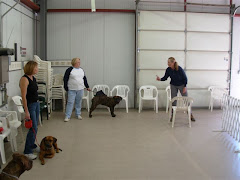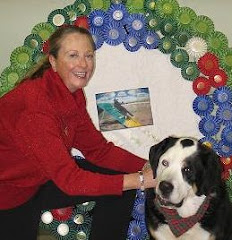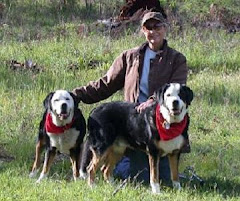Hi Jan,
I cannot get my dog not to greet people by jumping up on them. It doesn't make a difference if he is wearing a leash/drag line or not. I now just grab his collar and take him to his crate. I have tried to curb him and he stands back then hurdles himself forward into the new arrival. If I leave him in his crate for even five minutes he will then come out and be just fine. If we're expecting someone I have tried taking him for a walk ahead of their arrival, but that hasn't made a difference. I've asked people to ignore him and that didn't help. Any ideas? Thanks,
Myrna
PS: I have read several of your articles about this problem and nothing works. Do you think that I hurdle myself towards guests and Echo is following my lead? (!)
Myrna,
One of the reasons it's so difficult for all of us to correct the "jumping on guests" problem is because there is little or no regularity to the circumstances. Visitors are "random events," and random events are exciting and unpredictable. The NUMBER ONE element needed for any type of behavior modification is consistency. We need to be able to correct the behavior every time it happens, until the behavior is extinguished. With guests visiting, that's often not possible because our attention is on the guests, not the dog. Our corrections, then, are late, ineffective, or nonexistant. The dog, especially a friendly and sociable type, is so excited and stimulated by the company that he often doesn't heed (or even hear) your command or reprimand.
As you know, there are dozens of ways to stop the jumping, but none will work without consistent practice. If you wait until guests come to practice, you will be in "reactive" mode and it can be like trying to stop a locomotive by running after it.
If you're really committed to fixing the problem, you'll have to practice every day. Visitors will still be "random events," but they will be frequent enough to be routine. If you don't have guests coming every day, you'll have to invite them to do so. Try neighbor kids, grandkids, and whoever you can find. Practice at all doors in your home.
What you practice is up to you. The method or approach you use should be appropriate for your dog's personality. Do be "proactive," however, instead of "reactive." That is, be one step ahead of the dog's behavior instead of running to catch up with it.
You mentioned you now simply put Echo in his crate for a few minutes, and then he's calm when you let him out. That's very good. Now, instead of crating him, try putting him in an immediate down-stay. By doing so, you will be building an "invisible crate" around him. It will be more work, of course, because he'll try to crash through the walls and you'll have to correct him until he resigns himself to obedience. This is why you must "hire" some visitors, so you can set him up and work through the problem. (It's hard to do that with "real" visitors because we're too busy trying to be polite to them.)
Try teaching him a new game. Call it "Splat" or "Flop" or "Hit the Deck." Start out by teaching him to do a quick "down" at your side. REWARD him with a treat WHILE HE IS STILL DOWN. Then release him to get up and try it again. Do it about 500 times (feed him his whole dinner that way), gradually working out to a distance of about 10 feet. Next, reach outside the front door and ring your own doorbell. "Down" him. Make sure you reward him and then give the release ("Okay!") each time, and don't allow him to get up before you release him.
This procedure may help you with the indoor jumping, just as the crate has helped you in the past.
If he's jumping on guests coming up your driveway, sidewalk or porch, try this: Have a bowl of treats strategically located in a pocket. As someone approaches, call Echo's name to have him look at you, and then toss the treat a few feet in the opposite direction of the guest. Hopefully Echo will take off looking for the treat, and will temporarily forget the visitor. This break in the action could be long enough for him to lose the compulsion to jump.
I used to suggest that people have their dogs on drag leashes, let the dogs approach the visitors, and then correct sharply with a leash tug as soon as the dog launches into a jump. This will still work sometimes, but often the correction is too sporadic or ineffective to have an impact. BY ALL MEANS, correct your dog if you do have him on a leash when the jumping occurs...but don't rely on this as the only method. Instead, you must look at your own dog and determine what will make him choose to not jump. Find a method that makes it NOT WORTH IT and NOT GRATIFYING and perhaps even RISKY for him to decide to jump. Your options run from the all-positive treat methods to the strongly negative shock collar.
Finally, most of you know (having been taught by me or my proteges) that your dogs won't jump on YOU after the first night of Leadership Class because you have learned to "speak dog." The dog jumps up on you and you give him a bounce or bump with knee or lower leg. The abruptness of the move catches your dog by surprise, and he learns to put on the brakes before jumping up. This method works if you have at least two cooperative adults in your household who are committed to solving this problem. Simply bump or bounce the dog away EVERY time he comes up to you with the intention of jumping or even crowding you. You needn't be cross about it...just strong and abrupt. THIS WILL NOT WORK if one of you lets the dog get away with jumping on you EVEN ONCE. Again....consistency!
You've all been to the shops or wineries where resident dogs simply lie around looking bored as customers wander in and out. These dogs are so saturated with people that visitors are no longer exciting. So start throwing a big party every week, and invite everyone you know! Your dog will get bored with visitors too...TOO BORED TO JUMP!
Questions about dog behavior and training? Send them to: sandersagility@gmail.com.
Monday, April 7, 2008
Subscribe to:
Post Comments (Atom)


















No comments:
Post a Comment